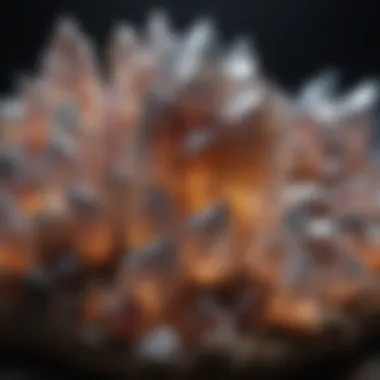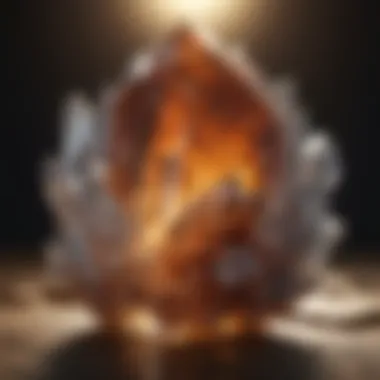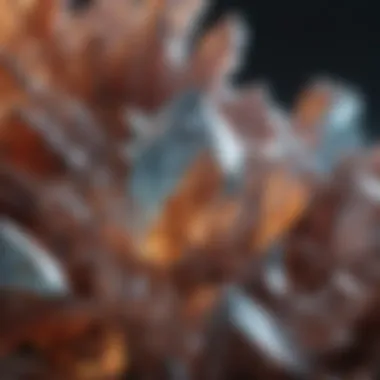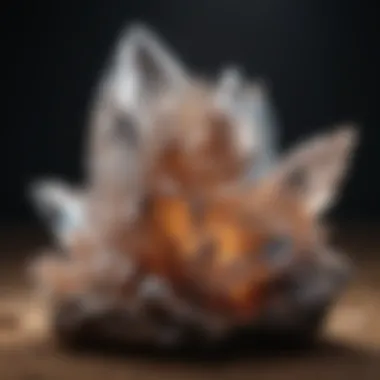Discover the Art of Distinguishing Various Crystal Varieties with Precision


Rock and Fossil Identification
Crafting a discerning eye for identifying various types of crystals is a skill that demands a keen attention to detail. When delving into the realm of rock and fossil identification, enthusiasts must familiarize themselves with the diverse array of crystal compositions, structures, and formations. Diving deep into the complexities of crystals, one must understand the importance of recognizing key types of rocks and fossils. By honing in on the distinct characteristics of each specimen, collectors can unveil a world of geological wonders waiting to be explored.
Collecting Tips and Techniques
For aspiring crystal collectors, mastering the art of gathering specimens is a crucial aspect of the hobby. To enhance the collecting experience, enthusiasts should adopt best practices that prioritize ethical and sustainable collecting methods. Locating prime collecting sites can prove to be a rewarding endeavor, leading collectors to coveted specimens that hold both intrinsic and scientific value. Safely extracting specimens from their natural habitats ensures the preservation of geological treasures for future generations to admire and study.
Preservation and Display
Once crystals have been meticulously collected, the task of preserving and displaying them in all their natural splendor arises. Implementing techniques for preserving rocks and fossils is essential in maintaining their pristine condition over time. Proper storage methods should be employed to safeguard specimens from environmental factors that could compromise their integrity. When it comes to showcasing these geological wonders, embracing creative display ideas can elevate the aesthetic appeal of any collection, transforming it into a captivating showcase of Earth's natural beauty.
Geological Insights
The journey of crystal identification transcends mere appreciation as it encompasses a deeper understanding of geological formations and processes. Delving into the historical significance of rocks and fossils unravels a tapestry of stories embedded within each specimen, offering invaluable insights into Earth's past. Exploring notable discoveries in the field of crystal identification sheds light on groundbreaking research and innovations that continue to shape our understanding of the natural world.
Introduction to Crystal Identification
In the vast world of crystals, being able to correctly identify different types is a fundamental skill for enthusiasts and collectors alike. This section serves as the gateway to understanding the intricate and captivating realm of crystals. By delving deep into the nuances of crystal identification, individuals can enhance their appreciation for these natural wonders. Whether you are a novice or a seasoned crystal aficionado, grasping the essentials of crystal identification can significantly enrich your experience and knowledge within this domain. It is the cornerstone that sets the stage for exploring the mesmerizing diversity found within the crystal kingdom.
The Importance of Knowing Your Crystals
The significance of correctly identifying crystals
As individuals immerse themselves in the world of crystal collecting, the significance of correctly identifying crystals emerges as a vital aspect. Precise identification not only adds value to a collection but also ensures accuracy in understanding each crystal's unique properties and characteristics. This attention to detail serves as the foundation for further exploration and study, enabling enthusiasts to deepen their connection with the crystals they encounter. By honing the skill of identifying crystals accurately, enthusiasts can confidently navigate the vast array of specimens available, fostering a deep appreciation for the nuances that set each type apart.
How identification enhances collection value
Identification plays a pivotal role in enhancing the value of a crystal collection. Knowing the specific attributes and properties of each crystal type allows collectors to curate their collections with intention and knowledge. This understanding not only elevates the aesthetic appeal of a collection but also adds depth and authenticity to it. By being able to discern between different types of crystals accurately, collectors can showcase a level of expertise that contributes to the overall allure and value of their collection.
Common Challenges in Crystal Identification
Issues with similar-looking crystals


One of the common challenges in crystal identification is encountered when dealing with crystals that bear a resemblance to each other. Distinguishing between closely related crystal types requires a keen eye for detail and an understanding of subtle distinctions. Failure to identify these differences accurately can lead to misclassification and misinformation within a collection, highlighting the importance of thorough examination and knowledge when differentiating between similar-looking crystals.
Variances in crystal forms
Another challenge that enthusiasts face is the variances in crystal forms that exist within the mineral world. Crystals exhibit a diverse range of forms based on their chemical composition and growth conditions, posing a test for identification skills. Understanding the variations in crystal structures and forms is essential for accurately categorizing and appreciating the unique characteristics of each specimen. By navigating these variances with precision, collectors can deepen their understanding of the rich spectrum of crystal formations present in nature.
Physical Characteristics to Look For
In the realm of crystal identification, understanding the physical characteristics of crystals plays a paramount role in distinguishing between different types. By delving into the color and transparency, crystal structure and habit, as well as cleavage and fracture, collectors can enhance their discernment abilities and elevate their expertise. This section serves as a crucial foundation for crystal identification, shedding light on the fundamental attributes that set each crystal type apart.
Color and Transparency
When it comes to assessing crystals, color and transparency are key factors that significantly influence the identification process. The hues and clarity of a crystal provide vital insights into its composition and potential properties. By meticulously examining the nuances of color and the level of transparency, collectors can gather essential clues about the crystal's origin and quality. Appreciating the spectral range of colors and variations in transparency not only enriches the visual appeal but also aids in deciphering the unique characteristics of each crystal.
Assessing Hues and Clarity
Assessing hues and clarity involves a meticulous study of the color spectrum displayed by crystals and the degree of transparency present. This detailed examination allows collectors to differentiate between different crystal types based on their unique color profiles and transparency levels. By honing the skill of assessing hues and clarity, enthusiasts can develop a keen eye for detail and enhance their ability to identify crystals accurately. Understanding the correlation between color variations and transparency degrees equips collectors with valuable information for their crystal identification journeys.
Understanding the Impact of Impurities
On the other hand, understanding the impact of impurities sheds light on the presence of foreign substances within crystals and its repercussions on their overall appearance and properties. Impurities can influence the color, transparency, and even the energetic properties of crystals, making them distinctive in their features. By grasping the implications of impurities, collectors can gain a deeper appreciation of each crystal's individual characteristics and assess their purity levels effectively.
Crystal Structure and Habit
Identifying Common Crystal Shapes
The identification of common crystal shapes serves as a fundamental aspect of crystal examination and differentiation. By recognizing the prevalent geometric forms that crystals adopt during their growth process, collectors can categorize crystals into specific types based on their structural configurations. Identifying common crystal shapes involves analyzing the symmetrical patterns and angles exhibited by crystals, providing valuable clues about their mineral composition and formation history. Understanding the diverse array of crystal shapes equips collectors with a systematic approach to classifying and identifying crystals accurately.
Recognizing Growth Patterns
Recognizing growth patterns involves discerning the distinctive structural developments that crystals undergo as they grow and evolve. By examining the growth patterns exhibited by crystals, collectors can uncover valuable information about the environmental conditions in which the crystals formed and the forces that shaped their structures. Recognizing growth patterns enables enthusiasts to interpret the intricate journey of a crystal's formation and gain insights into its geological significance. By studying the unique growth patterns of crystals, collectors can deepen their understanding of crystal identification and appreciation.
Cleavage and Fracture


Differentiating Between Cleavage and Fracture
Differentiating between cleavage and fracture is a critical aspect of crystal observation that involves distinguishing between two distinct modes of crystal breakage. Cleavage refers to the tendency of a crystal to break along specific planes of weakness, leading to smooth and flat surfaces, whereas fracture occurs when crystals break irregularly, resulting in rough and uneven surfaces. By understanding the differences between cleavage and fracture, collectors can assess the structural integrity of crystals and interpret their breakage patterns accurately. Mastery in discerning between cleavage and fracture enhances collectors' ability to evaluate crystal quality and authenticity with precision.
Observing Breakage Patterns
Observing breakage patterns entails closely examining the unique ways in which crystals break under stress or external forces. By observing the distinctive patterns formed during crystal breakage, collectors can infer valuable insights into the crystal's durability, cohesion, and internal structure. Identifying and interpreting breakage patterns enables enthusiasts to differentiate between natural fractures and intentional manipulations, safeguarding them against counterfeit or altered crystals. By honing the skill of observing breakage patterns, collectors can elevate their proficiency in crystal identification and ensure the integrity of their collections.
Visual Examination Techniques
Visual Examination Techniques play a crucial role in the comprehensive guide on identifying various types of crystals. By employing visual examination techniques, collectors can delve into the intricate details and characteristics that distinguish one crystal type from another. Examining crystals visually allows for a deep exploration of their color, clarity, structure, and unique features. This hands-on approach provides enthusiasts with a tactile experience, allowing them to develop a keen eye for identifying crystals accurately and confidently.
Using a Hand Lens or Microscope
Enhancing visibility of crystal features
The utilization of a hand lens or microscope in crystal identification enhances the visibility of intricate crystal features. By magnifying the crystal's surface, collectors can observe minute details that are often imperceptible to the naked eye. This heightened visibility aids in distinguishing between similar-looking crystals and uncovering hidden characteristics that define each crystal type. The ability to enhance visibility through magnification is a pivotal tool in accurately identifying crystals, contributing to the overall accuracy and precision of the identification process.
Spotting microscopic details
Spotting microscopic details is essential in crystal identification as it allows collectors to explore the intricate structures and formations at a microscopic level. Through the use of specialized equipment, enthusiasts can uncover fine details such as growth patterns, inclusions, and crystal habits that are pivotal in differentiating between crystal types. Spotting these microscopic details not only enhances the understanding of crystals but also adds depth to the identification process, enabling collectors to make informed decisions based on detailed observations.
Advanced Identification Methods
In the realm of crystal identification, advanced methods play a pivotal role in enhancing the accuracy and depth of understanding. By delving into specific gravity and hardness testing, collectors and enthusiasts can gain valuable insights into the unique properties of different crystals. Specific Gravity and Hardness Testing serve as fundamental techniques that aid in determining crystal density and evaluating mineral hardness, respectively. These methods not only provide quantitative data regarding the physical characteristics of crystals but also offer qualitative information that sets them apart.
Specific Gravity and Hardness Testing (250- words)
Determining crystal density
The determination of crystal density through specific gravity testing is a critical aspect of crystal identification. This method involves measuring the density of a crystal compared to the density of water. By understanding the specific gravity of a crystal, collectors can gain insight into its composition and potential mineral content. The key characteristic of determining crystal density lies in its ability to provide a numerical value that helps in distinguishing between different types of crystals based on their density. This quantitative approach offers a valuable parameter for categorizing crystals accurately, thus enhancing the overall identification process. While specific gravity testing offers precise measurements, its drawback lies in the requirement for specialized equipment and procedural adherence.
Evaluating mineral hardness


Evaluating mineral hardness is another crucial aspect of advanced crystal identification methods. This process involves assessing the resistance of a mineral to scratching and abrasion, typically using the Mohs hardness scale. The key characteristic of evaluating mineral hardness is its role in determining the relative hardness of crystals, which can aid in differentiation between similar-looking specimens. By understanding the hardness level of a crystal, collectors can also infer its durability and potential applications. While evaluating mineral hardness provides valuable insights, it may have limitations based on the subjective interpretation of hardness levels and the need for standard reference materials. Despite its challenges, this method remains a popular choice for crystal enthusiasts due to its effectiveness in identifying crystals based on their hardness properties.
Utilizing Online Resources for Identification
In the world of crystals, where accuracy in identification is paramount, leveraging online resources can significantly enhance one's abilities. The importance of utilizing online resources for crystal identification in this article lies in the accessibility and vast information they provide. Online platforms offer a treasure trove of knowledge that enables both novice collectors and seasoned enthusiasts to expand their understanding of crystals.
Digital Databases and Forums
Digital databases play a pivotal role in crystal identification by offering comprehensive information on various crystal types. Accessing these databases allows individuals to compare and contrast different crystals based on their physical characteristics, properties, and origins. This feature is particularly beneficial in aiding collectors to differentiate between similar-looking crystals and to identify rare or unique specimens. Having a central hub of crystal data streamlines the identification process and enhances the accuracy of classification.
Engaging with online collector communities
Engaging with online collector communities provides a valuable opportunity for crystal enthusiasts to interact, share knowledge, and seek guidance from experienced individuals. These communities foster a spirit of collaboration and learning, where members can discuss specific crystal identification challenges, post images for identification assistance, and engage in insightful discussions about rare finds or new discoveries. By participating in online forums, collectors can build a network of like-minded individuals who are passionate about crystals, creating a supportive environment for continuous learning and growth.
Mobile Apps for Crystal Identification
In a world where smartphones are ubiquitous, the integration of mobile apps for crystal identification has revolutionized how collectors analyze and categorize their specimens. Utilizing smartphone applications simplifies the identification process by providing instant access to a wealth of information at the touch of a screen. With features such as searchable databases, optical recognition technology, and in-app guides, these applications offer a convenient and efficient way to identify crystals on the go.
Scanning and matching crystal images
One of the key advantages of mobile apps is the ability to scan and match crystal images for quick and accurate identification. This feature enables collectors to capture images of their crystals, upload them to the app, and receive immediate feedback on potential matches or similar specimens. By harnessing the power of image recognition software, collectors can expedite the identification process, compare their specimens to reference materials, and gain insights into the unique characteristics of each crystal. While the convenience of scanning and matching crystal images is undeniable, users should exercise caution in relying solely on technology for identification purposes and supplement their findings with traditional research methods for comprehensive results.
Conclusion
In the realm of crystal identification, the conclusion serves as a vital culmination of knowledge and skills acquired throughout this comprehensive guide. As crystal enthusiasts delve into the intricacies of different crystal types, the conclusion acts as a roadmap to refining their identification acumen. By grasping the nuances of crystal characteristics and properties discussed within this article, collectors can elevate their expertise and discernment in distinguishing various crystals with confidence and precision. Understanding the significance of a robust conclusion is imperative as it encapsulates the essence of crystal identification and reinforces the fundamental principles elucidated in preceding sections.
Enhancing Your Crystal Identification Skills
Continual Practice and Observation
The art of crystal identification is a journey of continual refinement, with practice and observation serving as pillars of proficiency. Continual practice entails consistent engagement with crystals of diverse types, honing one's ability to discern subtle differences in color, structure, and other defining features. Through persistent observation, collectors develop a keen eye for distinguishing intricate details that set apart one crystal type from another. The key characteristic of continual practice and observation lies in its iterative nature, enabling enthusiasts to deepen their understanding and familiarity with a wide array of crystals.
Embracing continual practice bolsters collectors' confidence in identifying crystals accurately, fostering a nuanced appreciation for the uniqueness each specimen presents. While challenges may arise in the process, the resilience cultivated through continual practice empowers individuals to navigate complexities with ease, ultimately enhancing their overall proficiency in crystal identification. The advantage of continual practice lies in its ability to transform novices into adept connoisseurs, solidifying their expertise and contributing to a fulfilling journey of crystal exploration and discovery.
Seeking Guidance from Experts
Seeking guidance from experts stands as a cornerstone of advancing crystal identification skills, offering invaluable insights and mentorship to enthusiasts looking to refine their knowledge. Experts bring forth a wealth of experience and expertise acquired through years of immersion in the realm of crystals, providing guidance on nuanced aspects that may elude the untrained eye. The key characteristic of seeking guidance from experts lies in the personalized approach to learning, tailoring advice and practical tips to an individual's unique strengths and areas for improvement.
Engaging with experts enriches collectors' understanding of intricate crystal features, opening pathways to explore specialized techniques and nuanced observations that elevate their identification capabilities. While seeking guidance from experts offers unparalleled benefits in accelerating one's learning curve, it is essential to discern the credibility and expertise of mentors to ensure a fruitful and enriching learning experience. By tapping into the wealth of knowledge offered by experts in the field, enthusiasts can embark on a transformative journey of growth, refinement, and mastery in the art of crystal identification.







